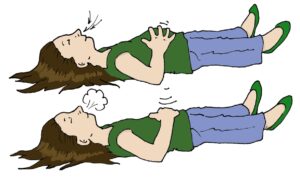When you breathe deeply and teach your child how to do it, it creates
calm, which is part of the relaxation process. And that aids visualization.
Most people don’t pay attention to their own breathing.
Watch your child when he is angry or upset. Does he sometimes hold his
breath, perhaps during a stressful situation? Does he sometimes breathe too
fast? Or perhaps even hyperventilate or become winded?
Breath-holding interferes with our ability to function normally and automatically.
Breath-holders often have chronic tension as well. This is of course
not only true for children; it is true for adults as well.
Here is a great activity for kids (and adults) to start learning how to breath for relaxation
Belly Breathing Activity
Purpose: Learn how to breathe from the belly (tummy).
Instructions to parent:
Find a quiet place where your child can lie down.
Instructions to child:
Shake out all your wiggles and just let all the tightness in your body
fall away.
When you are ready, lie down, and make yourself comfortable.
(Pause)
Close your eyes.
Find your belly button and put one hand on it and the other hand on
the center of your chest.
Simply notice how you are breathing. Which hand raises the most
as you breathe in?
(Pause)
Slowly, make one or two full breaths out.
Just notice how you are breathing.
(Pause)
Now place both hands on your belly.
(Pause)
Continue to simply be aware of your breathing.
Notice your belly rise when you breathe in (inhale), and fall when you
let air out (exhale).
Continue breathing through your nose, in and out.
If your child is having difficulty with this activity, try the following:
• Place a light weight such as a book on his belly so that he can
see and feel it rise and fall.
• Place a support such as a pillow under his head.
• Have him bend his knees until they point up towards the
ceiling and place the soles of his feet flat on the floor,
hip-width apart.
• Have him turn over and lie on his stomach. It may be easier for
him to notice his belly rising and falling because of the pressure
from the floor on his belly.
Activity from the book, See It. Say It. Do It!
By Dr. Lynn Hellerstein, Colorado Optometrist in Vision Therapy
- It’s Never too Late to Expand Your Vision - February 1, 2023
- It’s Never Too Late To Expand Your Vision Interview - January 27, 2023
- Dr. Hellerstein’s Featured COVD Interview - September 25, 2022



Comments are closed.